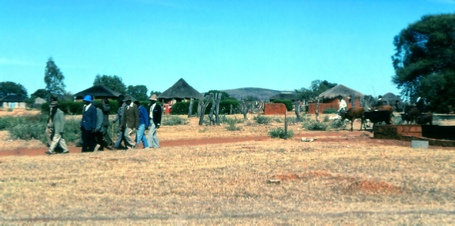© 2018 Dr Margaret Sheppard
It should be noted that although a man marries a woman (monna o nyala mosadi), a woman is married by a man (i.e. mosadi o nyalwa monna).
Among the Bangwaketse a marriage is not finally completed until Bogadi (bridewealth) has been presented by the bridegroom's family to the bride's family. Thus it can be seen that marriage is not just a union between two individuals, but between two families.
In the past much misunderstanding about the presentation of Bogadi seems to have arisen. Early missionaries believed it to be a process by which a man bought a wife and so tried to ban it among their Christian converts deeming it as a heathen practice.
Despite this Bangwaketse chiefs consistently retained the custom. For example in 1912 Seepapitso I asked a kgotla meeting: "Why have you abandoned the custom that is yours, I mean the custom according to which you used to marry? I'm not speaking about those who marry in the European manner in church, I am referring only to the marriage customs of us black people (batho ba bontsho). If you marry according to your custom, you ought to give bogadi so that it may be known that it is a true marriage (tseo yammamante)." (Schapera 1947b:51)
In 1913 he passed the Bogadi Law making it compulsory for bogadi to be paid except for those married only in a church. In 1914 a headman was punished for refusing to pay bogadi for his 4 wives or to appear in court. An age regiment was sent to confiscate all his cattle and each father was paid 6 head of cattle in lieu of bogadi, one was slaughtered to feed the regiment and the remaining 9 were kept by the Chief.
In 1930 Bathoen 11 extended the Bogadi Law to all Bangwaketse marriages, including those of church members, if the bride's father asked for it.
Among the Bangwaketse women were not sold to husbands. There is no bargaining over the number of Bogadi beasts prior to the marriage, but a man's family should present as many as they can afford. Both families gain status by the presentation -
The bridegroom's father or guardian helps to provide him with Bogadi beasts, also his paternal uncles and maternal uncles and his paternal aunts. His brother and mother may also help him and nowadays, as so many young men work in the cash economy, he may also contribute some. However no one is obliged to contribute and they will only do so if they can afford it. Thus it can be seen that many relatives are involved in the marriage of two individuals.
After the registration of the marriage at the Chief's Kgotla both families will return to their respective homes. The men lead and the women follow with the bride. When they arrive at the bride's home, there is much ululating and the women may be singing traditional songs such as "Coco (knock) we are arriving with a bride." The men return to sit in the family Kgotla whereas the women return into the yard and sit in the lolwapa of the house to be used for the marriage, this should be the home of the bride's mother. At the groom's home, his mother's own house is used as the focal point of the wedding in the lolwapa, as a child is supposed to be married from its mother's own house.

Bridewealth - Bogadi
Later in the morning (between 7.00 and about 9.30 a.m.) men from the groom's family arrive at the bride's Kgotla with the groom. They enter her family Kgotla, where her married male relatives will be seated in their meeting place, in front of their kraal, on chairs (the special so-



They shortly return with the bogadi (these beasts will have been waiting under the care of other relatives outside the bride's Kgotla area). As they arrive in the Kgotla area they shout praising the “special” beast e.g.: "Ee! Ee: Ee! Re a tsena mo ka kgomo ya rre e tshisana" (We are arriving with a cow without horns) . On another occasion all the cattle were "red" except for one that was "yellowish"; in another the odd cow was black. The calls were thus: "Re a tsena mo ka kgomo ya ga rre etshetla (yellow)" and "Re a tsena mo ya ga rre entsho (black)". One of the bogadi cattle is always a” special” one. Sheep but never goats may be used to make up the bogadi. For example in one bogadi presentation I observed 5 cattle (4 red, and one black) and 3 sheep.
As the women who are inside the lolwapa see the Bogadi arriving and hear the men bringing them shouting the words quoted above, they come outside the yard and start ululating loudly.
The bogadi beasts are then driven into the Kgotla and shown to the men from the bride's family. The men from the groom's family again kneel before the bride's male relatives and formally announce the arrival of the bogadi beasts. Then the beasts are driven in to the kraal.
At this point the ululating from the women is deafening.
After sitting with the bride’s male relatives for some minutes in the Kgotla, they then all enter the lolwapa and are served light refreshments. (The bogadi beasts usually stay in the kraal in the village for about a week, being taken out to graze and to be watered every day. This is so that everyone will have a chance to admire the bogadi beasts.)




All this time the female relatives and friends of the bride, who have been specially invited to do so, will have been preparing the bridal feast. (Bride wearing blue blanket on left)



The bride herself sits with the married women in the lolwapa, her Malome's wife is always at her side. Her mother in brown dress brings her baby for feeding.




